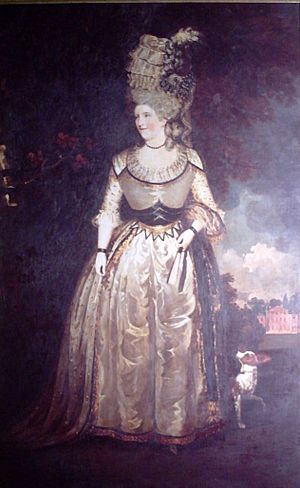Mary Bowes, Countess of Strathmore and Kinghorne facts for kids
Mary Eleanor Bowes, Countess of Strathmore and Kinghorne (born February 24, 1749 – died April 28, 1800) was a very important and wealthy woman in Britain during the 1700s. People sometimes called her "The Unhappy Countess."
She inherited a huge amount of money, making her one of the richest women of her time. Mary Eleanor Bowes was married twice. Her second husband, Andrew Robinson Stoney, caused her a lot of trouble. Besides her personal life, she was also very interested in plants (botany) and was one of the first people to fight for women's rights, especially regarding divorce.
Contents
Early Life and Great Fortune
Mary Eleanor Bowes was born in London. Her father, Sir George Bowes, was a very rich businessman. When Mary was only 11 years old, her father passed away. He left her an enormous fortune, which was worth between £600,000 and £1,040,000. This made her the wealthiest young woman in Britain, and possibly all of Europe!
Her childhood home was a grand estate called Gibside in County Durham. As a teenager, Mary was engaged at age 16 to John Lyon, who would become the 9th Earl of Strathmore and Kinghorne.
First Marriage to the Earl
Mary married the 9th Earl of Strathmore on her 18th birthday, February 24, 1767. Her father's will said that her husband had to take the Bowes family name. So, the Earl changed his name from John Lyon to John Bowes.
Mary and the Earl had five children together:
- Maria Jane Lyon-Bowes (1768–1806)
- John Bowes, 10th Earl of Strathmore and Kinghorne (1769–1820)
- Anna Maria Bowes (1770–1832)
- George Bowes (1771–1806)
- Thomas Lyon-Bowes, 11th Earl of Strathmore and Kinghorne (1773–1846)
Thanks to Mary's huge wealth, the couple lived a very grand life. While her husband worked on his family's castle, Glamis Castle, Mary wrote a play called The Siege of Jerusalem in 1769. She also loved botany, which is the study of plants. She even paid for an explorer named William Paterson to travel to Africa in 1777 to collect new plants for her.
After a few years, the Earl became very ill with tuberculosis. He passed away at sea on March 7, 1776, while traveling to Portugal.
Life as a Widow
When the Earl died, Mary was left with some debts, but her fortune was so large that she easily paid them off. As a widow, she also got back full control of her money and her family's properties, especially the mines and farms around her childhood home of Gibside.
In the summer of 1776, Mary met a charming but tricky man named Andrew Robinson Stoney. He managed to get close to her by pretending to be a brave "Captain" and even faked a duel to impress her. He pretended to be badly hurt and begged Mary to marry him as his "dying wish." Believing his trick, Mary agreed.
Second Marriage and Challenges
Mary married Stoney in a church, where he was carried down the aisle on a stretcher. Soon after, he made a quick recovery! Following her father's will, Stoney also changed his name to Bowes.
Mary had two more children during this marriage:
- Mary Bowes (born 1777)
- William Johnstone Bowes (born 1782)
After the wedding, Stoney Bowes tried to take control of Mary's fortune, which was common for husbands at that time. However, Mary had secretly signed a prenuptial agreement to protect her money. When Stoney found out, he forced her to sign a paper giving him control. He even took Mary and her daughter Anna Maria to Paris, and they only returned after legal action was taken against him.
In 1785, Mary managed to escape Stoney with the help of her loyal maids. She then started a legal process to get a divorce. Stoney Bowes then tried to kidnap Mary and take her to the north of England. She later said he threatened her life. The country was alerted, and Stoney Bowes was arrested, and Mary was rescued.
The divorce case and the kidnapping incidents became very famous trials in London. Stoney Bowes was found guilty of trying to kidnap Mary and was sent to prison for three years. The divorce case continued for many years. Mary eventually won the right to control her own money again. The divorce case was still ongoing when Mary passed away in 1800.
After Mary's death, Stoney Bowes was released from prison. He tried to challenge her will but lost. He later faced financial problems and died in 1810.
Later Life and Passing
After 1792, Mary lived a quiet life in Purbrook Park in Hampshire. She later moved to an isolated house called Stourfield House. She had many servants and spent a lot of time caring for her pet animals, especially her dogs, for whom she had special meals cooked daily.
Mary's three sons from her first marriage rarely visited her. However, two of her daughters, Lady Anna Maria Jessop and Mary Bowes (from her second marriage), lived with her. One of Mary's joys was watching her daughter Mary learn to ride horses, which gave her a lot of freedom.
Towards the end of her life, Mary made her final will and gave gifts to people in the local community. Mary Eleanor Bowes passed away on April 28, 1800. Her body was taken to London and she was buried in Westminster Abbey, a very famous church, in an area called Poets' Corner.
Mary Eleanor Bowes was the great-great-great-grandmother of Lady Elizabeth Bowes-Lyon, who later became the Queen Mother.
Archives
A collection of documents about Mary Eleanor Bowes's life is kept at the University of Dundee.



